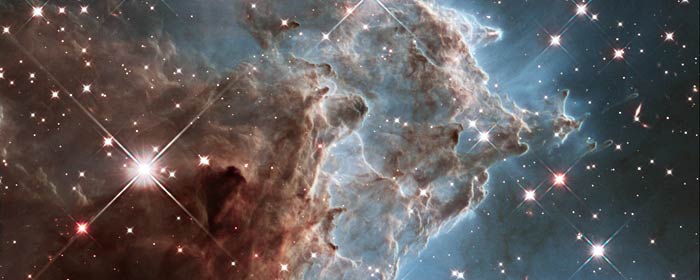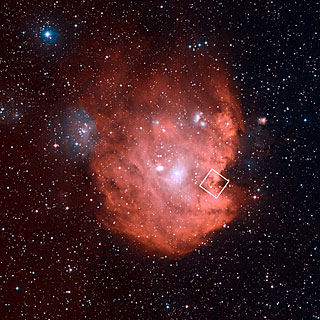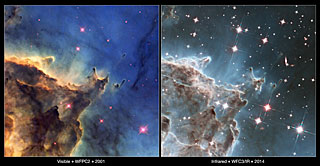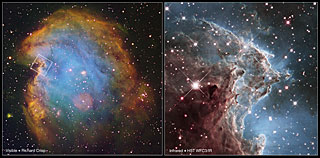Hubble revisits the Monkey Head Nebula for 24th birthday snap

To celebrate its 24th year in orbit, the
NASA/ESA Hubble Space Telescope has released a beautiful new image of
part of NGC 2174, also known as the Monkey Head Nebula. This colourful
region is filled with young stars embedded within bright wisps of cosmic
gas and dust.
NGC 2174 lies about 6400 light-years away in the constellation of Orion (The Hunter). Hubble previously viewed this part of the sky back in 2001, creating a stunning image released in 2011, and the space telescope has now revisited the region to celebrate its 24th year of operation.Nebulae are a favourite target for Hubble. Their colourful plumes of gas and fiery bright stars create ethereally beautiful pictures. Some of the most famous of Hubble's images have been of nebulae — for example, the telescope's 22nd and 23rd anniversary images of the Tarantula (heic1206) and Horsehead (heic1307) nebulae, and its festive 2012 image of planetary nebula NGC 5189 (heic1220).
The detail shown in this image lies within NGC 2174, a nebula which gets its more common name, the Monkey Head Nebula, from its curiously familiar shape when viewed in wide-field images.
The nebula is a violent stellar nursery, packed with the ingredients needed for star formation. However, the recipe for cooking up new stars isn't very efficient and most of the ingredients are wasted as the cloud of gas and dust disperses. This process is accelerated by the presence of fiercely hot young stars which trigger high velocity winds that help to blow the gas outwards.
A vibrant palette of colours can be seen in this new image of NGC 2174. Dark brown and rust-coloured dust clouds billow outwards, framed against a background of bright blue gas. These striking hues are formed by combining several Hubble images taken with different coloured filters, to reveal a broad range of colours not normally visible to the human eye.
The icing on this cosmic birthday cake takes the form of young white and pink stars sprinkled amongst the glowing clouds, pushing away the dark stellar nurseries in which they formed. The key ingredient in NGC 2174 is hydrogen gas, which is ionised by the ultraviolet radiation emitted by the young stars. As a result, this region is also known as an HII region [1] — a large cloud of ionised gas.
This image marks 24 years of Hubble. This milestone will be further celebrated by a conference being held in Rome, Italy, in March of this year. The conference, entitled Science with the Hubble Space Telescope IV, will highlight and celebrate the scientific breakthroughs that Hubble has made over the last two decades and look into the future at the topics and key questions that will shape the field of astrophysics in the next decade.
This portion of the Monkey Head Nebula was imaged in the infrared using Hubble's Wide Field Camera 3. Hubble's earlier Wide Field Planetary Camera 2 image from 2011 inspired its choice as the telescope's 24th anniversary image. A processed version of the WFPC2 dataset was entered into the Hubble's Hidden Treasures image processing competition by Yurij Tukachev.
Notes
[1] An HI region (pronounced "H-one") contains a lot of neutral hydrogen, an HII (pronounced "H-two") lots of ionised hydrogen, and a H2 region molecular hydrogen
New Hubble image of NGC 2174

To celebrate its 24th year in orbit, the NASA/ESA Hubble Space Telescope has released this beautiful new image of part of NGC 2174, also known as the Monkey Head Nebula.
NGC 2174 lies about 6400 light-years away in the constellation of Orion (The Hunter). Hubble previously viewed this part of the sky back in 2011 — the colourful region is filled with young stars embedded within bright wisps of cosmic gas and dust.
This portion of the Monkey Head Nebula was imaged in the infrared using Hubble's Wide Field Camera 3.
Credit:
NASA, ESA, and the Hubble Heritage Team (STScI/AURA)
Wide field image of NGC 2174 (ground-based view)

This image, a composite of red and blue exposures from the Digitized
Sky Survey 2, shows the region of sky surrounding NGC 2174, more
popularly known as the Monkey Head Nebula. To celebrate its 24th year
observing Hubble revisited the Monkey Head Nebula and a brand new image
was released of one of its breathtaking pillars. The small square near
the centre of this image is where the pillar can be found.
Credit:
NASA, ESA, Digitized Sky Survey (DSS), STScI/AURA, Palomar/Caltech

Credit:
NASA, ESA, Digitized Sky Survey (DSS), STScI/AURA, Palomar/Caltech
Visible and Infrared Comparison of NGC 2174

This image compares two views of the same detailed area in the
star-forming nebula NGC 2174 from the Hubble Space Telescope. On the
left is a visible-light image made by WFPC2 observations taken in 2001 —
and released in 2011
— and on the right is an image made by the WFC3 infrared camera.
Infrared light penetrates more dust and gas than visible light, allowing
details to become visible. A jet of material from a newly forming star
is visible in one of the pillars, just above and left of centre in the
right-hand image. Several galaxies are seen in the infrared view, much
more distant than the columns of dust and gas.
Credit:
NASA and ESA
Acknowledgment: NASA, ESA, and the Hubble Heritage Team (STScI/AURA), and J. Hester

Credit:
NASA and ESA
Acknowledgment: NASA, ESA, and the Hubble Heritage Team (STScI/AURA), and J. Hester
Location of the Hubble IR Detail in NGC 2174

This image shows the region of NGC 2174, taken in infrared and
released for Hubble's 24th birthday, in its wider context. On the left
is a ground based image taken by an amateur astrophotographer of the
star-forming nebula in visible light, with an outline showing the area
of the detailed Hubble image. On the right is a small detail of a
star-forming column in the nebula, made by Hubble's WFC3 infrared
camera.
Credit:
NASA and ESA
Acknowledgment: NASA, ESA, and the Hubble Heritage Team (STScI/AURA), and R. Crisp
VIDEOS -VIDEOS-VIDEOS-VIDEOS
Credit:
NASA and ESA
Acknowledgment: NASA, ESA, and the Hubble Heritage Team (STScI/AURA), and R. Crisp
VIDEOS -VIDEOS-VIDEOS-VIDEOS
Hubblecast 73: Hubble revisits the Monkey Head Nebula for 24th birthday snap
In April of this year, the NASA/ESA Hubble Space Telescope will be
celebrating 24 years of observing. To celebrate this milestone, the
observatory is releasing a brand new image of part of NGC 2174,
otherwise known as the Monkey Head nebula. This new Hubblecast episode
showcases this beautiful image, which views a colourful region filled
with young stars embedded within bright wisps of cosmic gas and dust.
Credit:
ESA/Hubble
Credit:
ESA/Hubble
- Directed by: Georgia Bladon
- Visual design and editing: Martin Kornmesser
- Written by: Nicola Guttridge/Georgia Bladon & Nikita Marwaha
- Narration: Sara Mendes da Costa
- Images: NASA, ESA
- Videos: Zoom video: NASA, ESA, and G. Bacon (STScI)
- Music: Steve Buick
- Web and technical support: Mathias Andre and Raquel Yumi Shida
- Executive producer: Lars Lindberg Christensen
Zooming in on NGC 2174
This video sequence begins by zooming through the constellation of
Orion (The Hunter), finishing on new NASA/ESA Hubble Space Telescope
observations of part of NGC 2174, also known as the Monkey Head Nebula.
NGC 2174 lies about 6400 light-years away. Hubble previously viewed this part of the sky back in 2011, and the space telescope has now revisited the region to celebrate its 24th year of operation.
This image was created using infrared observations from Hubble's Wide Field Camera 3.
Credit:
NASA, ESA, and G. Bacon (STScI)
Acknowledgement: A. Fujii, the Digitized Sky Survey 2, and the Hubble Heritage Team (STScI/AURA)
NGC 2174 lies about 6400 light-years away. Hubble previously viewed this part of the sky back in 2011, and the space telescope has now revisited the region to celebrate its 24th year of operation.
This image was created using infrared observations from Hubble's Wide Field Camera 3.
Credit:
NASA, ESA, and G. Bacon (STScI)
Acknowledgement: A. Fujii, the Digitized Sky Survey 2, and the Hubble Heritage Team (STScI/AURA)
Panning across NGC 2174
This video sequence pans across new NASA/ESA Hubble Space Telescope
observations of part of NGC 2174, also known as the Monkey Head Nebula.
NGC 2174 lies about 6400 light-years away. Hubble previously viewed this part of the sky back in 2011, and the space telescope has now revisited the region to celebrate its 24th year of operation.
This image was created using infrared observations from Hubble's Wide Field Camera 3.
Credit:
NGC 2174 lies about 6400 light-years away. Hubble previously viewed this part of the sky back in 2011, and the space telescope has now revisited the region to celebrate its 24th year of operation.
This image was created using infrared observations from Hubble's Wide Field Camera 3.
Credit:

Comentarios